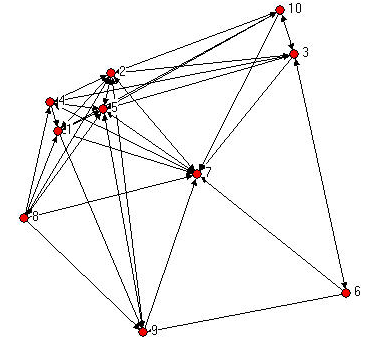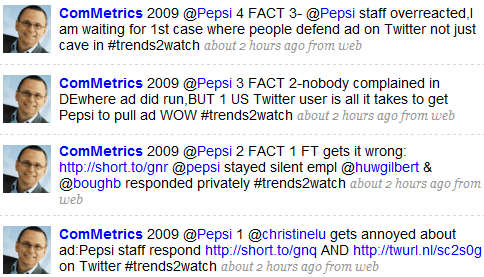- On the bright side, the chocolatiers will do fine during this recession. Still, the question for you and me is surely whether weak ties on Twitter will help bring home the bacon during 2009’s economic downturn. Twittering is more of the same, only a bit cleverer: it fails to alter the basic situation, namely, that you must get your followers’ attention to ensure impact.
We have continued to provide you with posts focusing on matters important to Twitter users, such as:
Twitter tricks, tips and FAQs
Best 100 Twitter tools
Twitter: means getting a better conference experience
SMIuk08 Conference: be passionate, monitor Twitter is the call
Social network analysis is a technique that considers social relations; the important parts are nodes and their ties.
Nodes are the individual actors within the network, such as one’s friends and family members.
Ties are the relationships between the actors – strong or weak ties, for instance.

The term “six degrees of separation” was coined in an article by Stanley Milgram in 1967, a new way to describe the small world problem (Psychology Today, 1967, Vol. 2, 60-67). It put forward the assumption that everyone in the modern world was capable of connecting to another person by linking people and interests.
Actors who have more ties to other actors may be in an advantageous position, and those who display high out-degree centrality are often said to be influential actors. In the chart above, simply counting the number of in-ties and out-ties of the nodes suggests that certain actors are more ‘central’ here (e.g., 2, 5 and 7).
How does Twitter fit here?
All things being equal, weak versus close ties with Twitter is a matter of how many users I personally follow (called follow on your Twitter page) and those following me (Twitter calls this group following). Practically speaking, having close ties with those 15,000 that I follow or those 11,000 that follow me (or heaven forbid, all 26,000!) is impossible, unless I do nothing more than work to attain closer ties all day long. I do not, do you?
We propose to define ties in the context of Twitter followers and tweets as follows:
close ties = sending the person a message (also called public reply) by starting with @username (or having @username somewhere in the tweet) at least once every month.
occasional direct reply = sending the person a message starting with @username (or having @username somewhere in the tweet) more than once a year but less than three times per quarter.
The above might be moderated by geographical proximity. Hence, if your followers all live in the same city, close ties may form through other means of communication besides Twitter. Examples include Google Talk or meeting each other for lunch.
Below, I outline matters pertaining to close ties and social networks as they pertain to people I follow who are my friends, customers, colleagues or associates and so forth.
Friends and Twitter
What do close ties and proximity mean when it comes to using Twitter with your personal friends?
In my case, most of my long-time friends rarely if ever use Twitter. In part this may be the result of my age (thirty something for sure ![]() ). Nonetheless, even younger folks seem to prefer face-to-face meetings, talking on the phone or using an SMS to reach their pals instead of Twitter or other micro-blogging tools. Using these means may be a more effective way of keeping a friendship alive than staying in contact via Twitter.
). Nonetheless, even younger folks seem to prefer face-to-face meetings, talking on the phone or using an SMS to reach their pals instead of Twitter or other micro-blogging tools. Using these means may be a more effective way of keeping a friendship alive than staying in contact via Twitter.
Proposition 1: an SMS or a phone call helps stay in touch while having lunch together will achieve much more and allow you to re-connect with your friend(s) far better than using Twitter.
Family and Twitter
Having a conversation with family members via Twitter is probably impossible. Family members tend to have rich conversations that encompass both verbal and non-verbal messages. Hence, sometimes even using the phone does not allow one to enjoy and accurately decode the richness of the conversation.
Proposition 2: your mother will definitely prefer a visit over you sending a tweet, while your brother might not be interested enough to follow you either.
I have addressed some of this here: Twitter: wake up and smell the coffee – have a conversation instead
Current/Potential Clients and Twitter
For our consultancy business in the area of risk management and IT security I can safely say that Twitter does not really play a role.
Even for our social media clientele, Twitter is difficult to use to provide them with gems that they consider worth their time. As the example below shows, to provide the context needed I may have to tweet several times to make sure the message can be understood.
This does not help develop close ties but, instead, may allow my clients to see what I am up to during the week and allow me to share with them. However, even those subscribing to our web-based software benchmarking service at My.ComMetrics.com appear to prefer subscribing to our blog instead of becoming Twitter followers.
Proposition 3: Unless your clients use @username and respond to you directly or re-tweet your tweets to their clients, Twitter may not affect your bottom line (yes, I know it could but does not have to be different for a Fortune 500 firm such as Dell or Pepsi Cola).
Professional network
A person’s professional network becomes ever more important in an economic downturn, especially when looking to secure further jobs or contracts that provide the income needed to pay the bills every month. As Warren Sukkerneck has demonstrated, Twitter may work as far as networking is concerned in some professions, but don’t hold your breath. For most of us, it is safe to conclude that your next job or contract will not come through Twitter.
Most of the people who have worthwhile things to say when tweeting are those who appreciate complexity. Accordingly, I am always trying to discover them within my professional network in order to follow them via Twitter.
Proposition 4: Imagine you pay a monthly fee out of your own pocket for each person you choose to follow on Twitter. Accordingly, choose who you want to follow wisely. In turn, you will save a lot of time that you can spend talking with your clients instead (e.g., calling them, visiting their premises and so forth).
Bottom line
All things being equal, proximity makes it easier for one to meet in person. As well, micro-blogging using Twitter and similar tools is one of many communication options one has for contacting a friend or business associate. Others are instant messaging, telephone or e-mail, for instance.
People forget to include the time it takes to and from the car parking lot and so forth. Similarly, we tend to forget how much we become distracted by and how much time we spend on Twitter every workday.
Twitter easily takes more than one hour a day. The question is whether this time is spent effectively or if we are frittering it away. Just for comparison, imagine spending an hour doing physical exercise each day. Is the return on investment higher for you given the improved quality of life you’ll enjoy? What about using Twitter each day; is the return on this investment better than rubbing shoulders with your clients every day?
It looks like Stowe Boyd advises us all to keep our ‘following’ count ≤ 100, and with good reason. I follow Valdis Krebs’ advice when adding new people to follow: after about two weeks, I either keep them or substitute them for someone else. I have a core of about ten people that do not change much, and then another ring of five to fifteen that churn. People that stay in this latter group eventually become part of the core of people I follow closely. This group grows slowly over time.
For me personally, the benefits of Twitter are more about ‘cultivating weak ties‘ or loose connections between me and my followers by being able to ask for their advice and providing them with input for a problem to be solved on their end (see Joanne Jacobs for a nice blog post on this issue).
=========>
Here’s what I’m suggesting for today. First, re-allocate 50 percent of the time you spend daily using Twitter to playing or talking with your kids, friends and family members. Whatever you decide, spend your time wisely. Remember, even following your own tweet plan quickly adds up to more than 30 minutes everyday.
Second, the above makes it obvious, in 2009 I must try harder. I’ve also gotta have some of your attention. Give it to me by subscribing to this blog. ![]()
Finally, I would also like to hear from you if you use Twitter in one way or another with your friends, family and/or associates: how is it working for you, are there any tips you could pass on to your fellow readers of this blog? I suggest you write a comment below and join the conversation now, because inquiring minds want to know what you have to say.
=========>

Pingback: Elliott Lemenager
Pingback: 3 golden rules for best practice: LinkedIn and Xing - benchmark, using LinkedIn as competitive intelligence tool, building your brand, social media analytics, social networks, effective use, wasting time, crowdsourcing, crowdslaving, are we having a conve
Pingback: Bryan Foster
Pingback: meebee
Pingback: Urs E. Gattiker
Pingback: MyComMetrics
Pingback: CyTRAP
Pingback: tim gier
Pingback: Rakesh Ojha